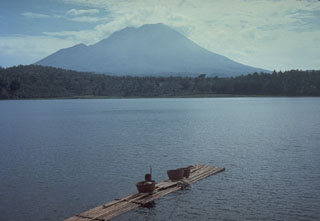Report on Lamongan (Indonesia) — January 2006
Bulletin of the Global Volcanism Network, vol. 31, no. 1 (January 2006)
Managing Editor: Richard Wunderman.
Lamongan (Indonesia) Above-background seismicity during 5-6 January 2005
Please cite this report as:
Global Volcanism Program, 2006. Report on Lamongan (Indonesia) (Wunderman, R., ed.). Bulletin of the Global Volcanism Network, 31:1. Smithsonian Institution. https://doi.org/10.5479/si.GVP.BGVN200601-263320
Lamongan
Indonesia
7.981°S, 113.341°E; summit elev. 1641 m
All times are local (unless otherwise noted)
Elevated seismicity occurred at Lamongan on 5-6 January 2005. From 1200 to 0700 on 5 January, 22 events occurred with Modified Mercali Intensity (MMI) of 1. At each of three times (0331, 0447, and 0524) observers noted an event of MMI 3. During this period, instruments detected continuous tremor with an amplitude of 3 to 15 mm. On 5 January there were 282 local tectonic earthquakes and 53 volcanic A-type earthquakes. The volcano alert level was raised to 2.
On 6 January 2005, 107 volcanic A-type earthquakes were recorded. Local tectonic earthquakes over the two day period occurred 159 times, of which 10 of them were events had Modified Mercali Intensity (MMI) of 1-3.
Geological Summary. Lamongan, a small stratovolcano located between the massive Tengger and Iyang-Argapura volcanic complexes, is surrounded by numerous maars and cinder cones. The currently active cone has been constructed 650 m SW of Gunung Tarub, the volcano's high point. As many as 27 maars with diameters from 150 to 700 m, some containing crater lakes, surround the volcano, along with about 60 cinder cones and spatter cones. Lake-filled maars, including Ranu Pakis, Ranu Klakah, and Ranu Bedali, are located on the E and W flanks; dry maars are predominately located on the N flanks. None of the maars has erupted during historical time, although several of the youthful maars cut drainage channels from Gunung Tarub. The volcano was very active from the time of its first historical eruption in 1799 through the end of the 19th century, producing frequent explosive eruptions and lava flows from vents on the western side ranging from the summit to about 450 m elevation.
Information Contacts: Darwin Volcanic Ash Advisory Centre (VAAC), Bureau of Meteorology, Northern Territory Regional Office, PO Box 40050, Casuarina, NT 0811, Australia (URL: http://www.bom.gov.au/info/vaac/).

